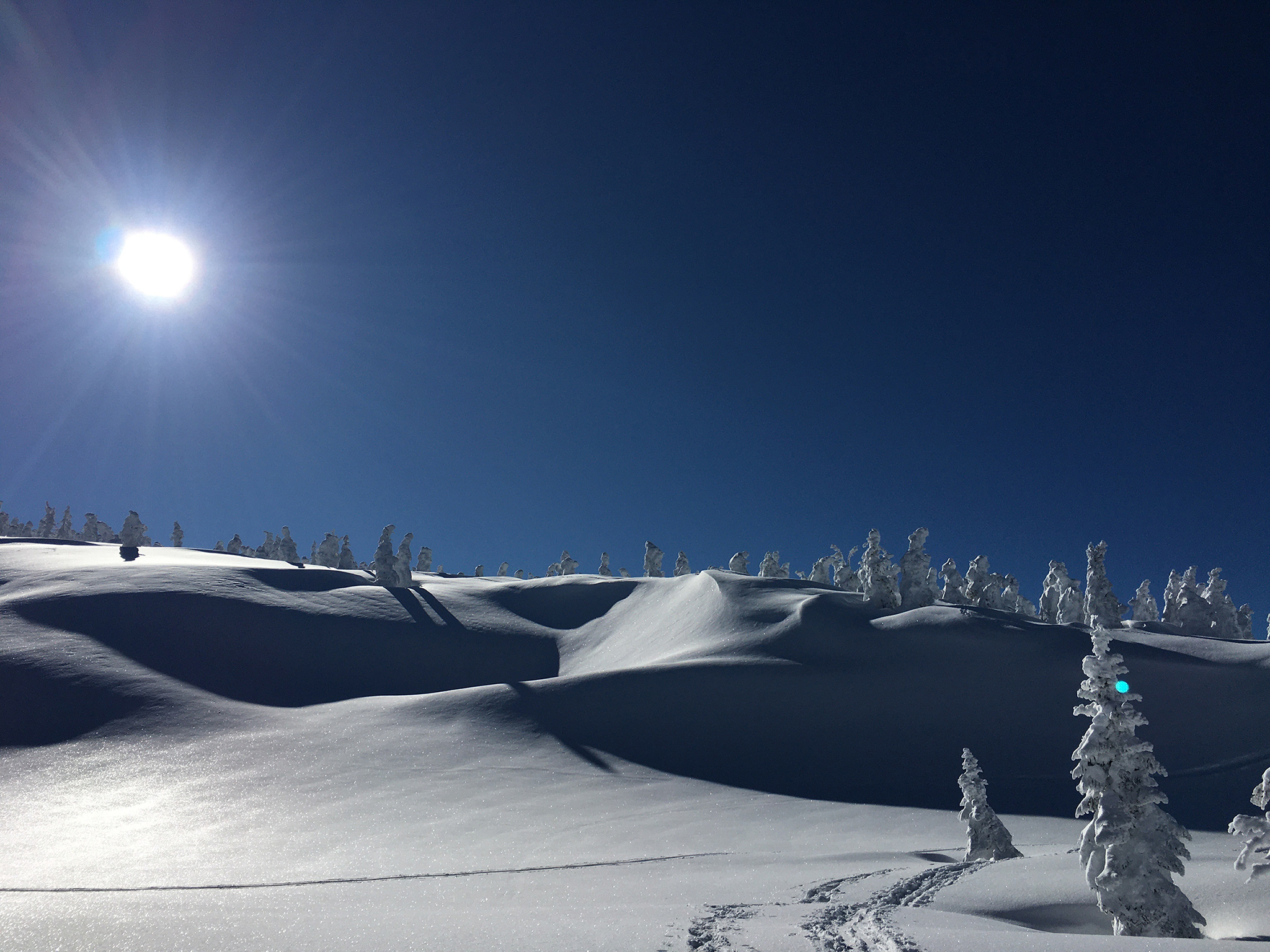事業計画区域には十和田八幡平国立公園も含まれており、ほぼ全てが森林区域で保安林にあたります。
大規模な森林伐採で、ニホンカモシカやイヌワシ、クマタカなど、動植物の安住の地は奪われ、土地の改変で山の保水力が失われれば、土砂崩れなど災害の危機も増すばかり。
豊かな命が育まれる自然環境は一度失われたら、百年以上取り戻すことはできません。
それほどまでに多大な犠牲を払う風力発電開発はいったい誰のため?
立ち止まり、未来への自然環境を考える必要があるのではないでしょうか?
Eurus Energy Holdings Ltd. is planning Japan's largest-scale onshore wind power generation project, the first of its kind in Japan, around Hakkoda Mountains, which is located in the six municipalities of Aomori-shi, Towada-shi, Hiranai-machi, Noheji-machi, Shichinohe-machi, and Tohoku-machi, including Towada-Hachimantai National Park.
Total output : approx. 600,000kw (single unit output: 4,000-5,000kw x 120-150 units)
Wind turbine : height: 150-200m, rotor diameter: 130-160m
Project area : approx. 17,300ha
The project area includes the Towada-Hachimantai National Park, and almost all of a protected forest.
Large-scale deforestation has taken away the habitat of animals and plants such as Japanese serows, golden eagles, and hawks, and the loss of water retention capacity in the mountains due to land alteration has only increased the risk of landslides and other disasters. Once the natural environment where abundant life is nurtured is lost, it cannot be recovered for more than a hundred years.
Who is the purpose of wind power development, which requires such great sacrifice?
It’s time to stop and think about the future of our natural environment, right?
景観は台無し
観光へ多大なダメージ
青森市内から奥入瀬・十和田湖へつながる八甲田山系は、国内屈指の観光名所。ブナの新緑が輝く春、紅葉の秋、そしてパウダースノーに憧れ海外からも人々が集う白い季節・・・
四季折々の表情で人々を魅了し、一年中絶えることのない観光客の人気スポットが、巨大風車群で景観を台無しにされてしまいます。
Hakkoda mountains, which connects Aomori-shi to Oirase and Lake Towada, is one of the most famous sightseeing spots in Japan.
The mountain range is one of the most popular tourist spots in Japan, attracting tourists all year round. The scenery is ruined by the giant wind turbines.
野鳥ら動植物が犠牲に
生態系に及ぼすリスク
事業計画区域は、イヌワシ・クマタカ等の稀少猛禽類の生息域と大きく重なっています。
計画が実施されれば、すみかが奪われ、両種の個体群は絶滅の危機に瀕します。ガンやハクチョウなど渡りの経路になっており、バードストライク(鳥類が風力発電機に衝突して死亡する事故)が多発する可能性も高いです。
バードストライクで犠牲になった鳥類は、米国では年間40万羽という推計もあり、「風力発電は本当にクリーンな発電なのでしょうか?」と警鐘を鳴らす鳥類研究者も少なくありません。
The project area overlaps with the habitat of rare birds of prey such as golden eagles and hawks.
The project area overlaps the habitat of rare birds of prey such as the golden eagle and bear hawk. If the project is implemented, their habitat will be taken away and the populations of both species will be in danger of extinction. The area is also a migratory route for geese and swans, so there is a high possibility of bird strikes. Some estimates put the number of birds killed by bird strikes at 400,000 per year in the U.S. "Is wind power really clean power? Many bird researchers are sounding the alarm.
土砂くずれや水の汚染
災害のリスク
事業計画区域では、火山噴出物からなる地層が広がっているため、本事業で森林が伐採され、土地が大規模に改変されると、土砂崩れのリスクが高まります。
そのうえ、酸性水の発生や重金属類の流出で、周辺の川や海の環境も汚染するリスクを指摘する専門家の声もあります。
Since the project area is covered with strata of volcanic eruptions, the risk of landslides will increase if the forest is cut down and the land is altered on a large scale.
In addition, some experts have pointed out the risk of polluting the environment of the surrounding rivers and oceans with the generation of acidic water and the discharge of heavy metals.
送電ロスは?
“費用対効果”の説明を
風力発電は“風”という自然エネルギーを有効に使う手段ですが、“風任せ”。無風時はもちろん、基準以上の強風時には停止して発電できなくなる不安定な電力源です。発電する山間から消費地の市街地までの長距離の送電で、かなりの量が失われる“送電ロス”が起きます。さらに送電網整備のために、送電線や送電設備の建設による自然破壊も避けられません。
Wind power generation is an effective way to use the natural energy called "wind", but it is "left to the wind". Wind power is an unstable source of electricity that can stop generating when there is no wind, or when the wind is stronger than the standard. The transmission of electricity over long distances, from the mountains where the power is generated to the urban areas where it is consumed, results in "transmission loss," where a significant amount of power is lost. In addition, the construction of power lines and transmission facilities to improve the power grid will inevitably destroy nature.
これが本当に地球環境のため?
地球温暖化を止めるためのCO
2削減、再生可能エネルギーへの転換が求められている中、自然エネルギーの利用は必要でしょう。しかし、豊かな自然を大規模に破壊してまで作られる電力が、地球環境のためでしょうか?
世界各国が取り組む「SDGs」目標で、陸と海の豊かさを守ろうと目指しているのに、豊かな生態系を崩す行為は本末転倒だと思います。
風力発電の事業期間は約15~20年。恒久的に必要な自然環境と天秤にかけることは間違っていて、払う代償が大き過ぎると思います。日本ではこうした風力発電計画に対し、環境影響評価法という制度で事業者側が調査、評価し進めていきます。この仕組みでは、風力発電乱開発が日本の自然環境を破壊し続けるでしょう。
With the need to reduce CO2 emissions and shift to renewable energy sources to stop global warming, the use of natural energy is probably necessary. However, is electricity produced at the cost of destroying the rich natural environment on a large scale beneficial to the global environment?
The "SDGs" goals that countries around the world are working on aim to protect the abundance of the land and sea, but I think that destroying the rich ecosystem is not the way to go.
The project period for wind power generation is about 15 to 20 years. It is wrong to weigh this against the permanent need for a natural environment, and I think the price to be paid is too high. In Japan, wind power projects are subject to a system called the Environmental Impact Assessment Law, under which the business side conducts surveys and evaluations. Under this system, wind power development will continue to destroy Japan's natural environment.
私たちは(仮称)みちのく風力発電事業の中止、撤回を求めます。
We call for the cancellation and withdrawal of the Michinoku Wind Power Project.
この問題を機に、自然環境、再生エネルギー、自然エネルギーを見直して、後世に豊かで美しい自然を残していけるよう、ご賛同をお願いいたします。
We ask for your support so that we can use this issue as an opportunity to review the natural environment, renewable energy, and natural energy, and leave a rich and beautiful nature for future generations.













